
We’re republishing some of our most-read posts this week on JacoBLOG (and killing time until Monday when everyone is back in action). I would be remiss if I didn’t devote a little bandwidth to the state of radio sales.
As many learned the hard way last year, your ratings can be stellar, but they are no longer the guarantor of strong revenue. And that, in and of itself, is reason for concern in 2020. Ratings are important, of course, but so is the ability to demonstrate radio’s efficacy as a marketing vehicle.
This post generated a great deal of commentary from both programming and sales types when it was first published last year. And we hope this re-post is the catalyst for strategic conversations when everybody returns from their holiday breaks.
We appreciate your readership of this blog, as well as your timely and important commentary. Radio is small community, but it’s full of very diverse and emotional opinions. – FJ
If you’re in sales and management and today’s blog post title pisses you off, I’m sorry. After all, what does a guy who’s spent his entire career on the content side know about sales?
Well, the truthful answer is, “Probably not a whole lot.” But I would turn the question back around and ask: “What do YOU know about radio sales these days?”
Or perhaps we should say media sales.
That’s because the world of marketing has been rocked by the Internet, and all the options it has spawned. It wasn’t enough that there was SEO, SEM, Google Adwords, Facebook ads, and the other tools that have been around for years. Now AI – Artificial Intelligence – is being deployed to better predict ad spending and audience targeting patterns.
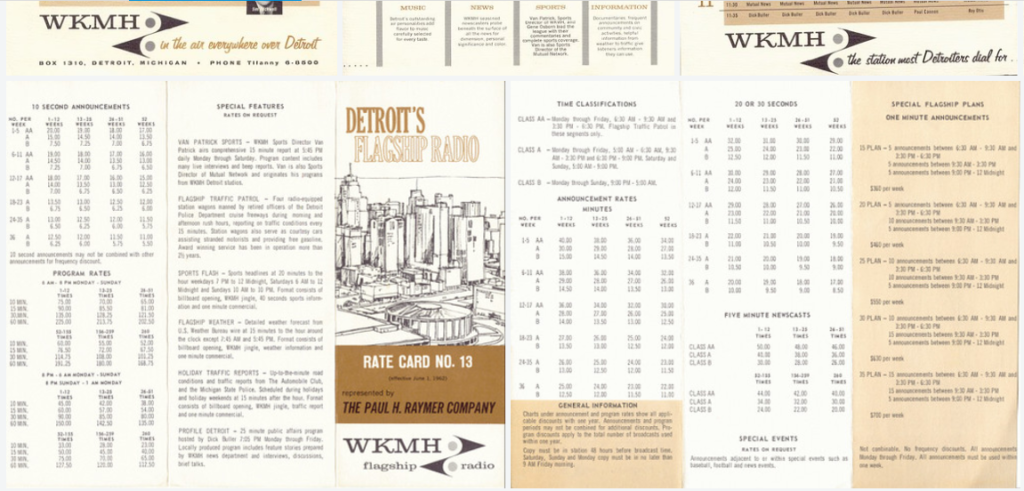
If you recognize the artifacts pictured above, you’ve been around the radio business for a long time. It’s an old rate card, the pricing device radio stations used back in the days when they could demand – and often get – their aspirational advertising rates.
If some of those rates from an AM radio station in Detroit in 1963 actually look attractive to you today, well, that says a lot about how far we’ve come. Or fallen.
I spent a night in Philadelphia this week, and I started thinking about a famous Philadelphian – John Wanamaker.
You’ve never heard of him? He was a fascinating guy, something of a Renaissance man. Back in the 1880s through the early 20th century, Wanamaker was a businessman, a political force, and even a religious leader,
And he became something of an advertising/marketing guru because of his ownership of Philly’s iconic department store – yes, Wanamaker’s. He opened his first store as the Civil War was getting started.
Wanamaker’s slogan? “One price and goods refundable.” Simple, to the point, and very marketable. But the question back in the 1860s, the advertising scene was confusing. Merchants like Wanamaker tried various ad platforms (they weren’t called platforms back then), but often were unable to determine which were effective.
And that led Wanamaker to make this statement that every advertising maven from David Ogilvy to Don Draper has uttered at one time or another:
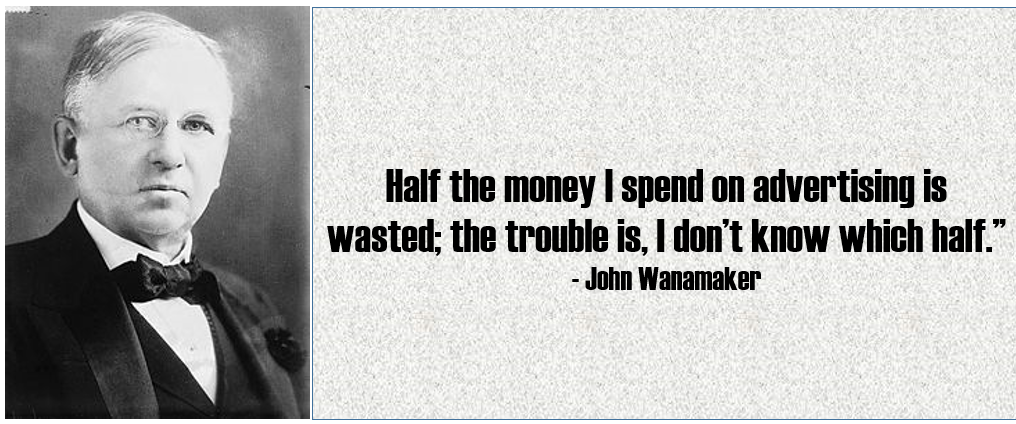
And here we are, some 120 years later, and advertisers are even more clueless and confused about the effectiveness of their marketing dollars.
This, despite so-called “accountability,” ROI, artificial intelligence, and all the other data-driven tools now available to any media buyer with a laptop.
Somehow, the debate rages. And one of the biggest advertisers in the world – Procter & Gamble – continues to test the marketing waters, trying to find the right balance between digital and traditional advertising tools.
And if P&G is struggling to answer Wanamaker’s existential question, just imagine what media buyers, local merchants, and even large agencies are experiencing.
There are no “best practices.” There is no yardstick. There are no rules. As I participate in budget meetings at both the local cluster level and with some of radio’s leading broadcasters, the sales conundrum has only intensified.
Radio exces can’t find qualified, strategic sales managers, much less salespeople. They are unable to settle on how individual stations and clusters should be sold and marketed. They continually debate the configuration of sales teams, and whether there should be dedicated digital sellers.
Many assets – podcasts, streams, websites, apps – are going unsold. Or they’re packaged as remnant advertisement where the going rates are downright embarrassing.
Many stations are facing low demands on their inventories – despite outstanding ratings. The time-honored equation: great ratings = strong demand and high rates is breaking down.
Advertisers are correspondingly roiling in confusion as a result. This came through loud and clear when staring at this chart produced by Borrell Associates this week.
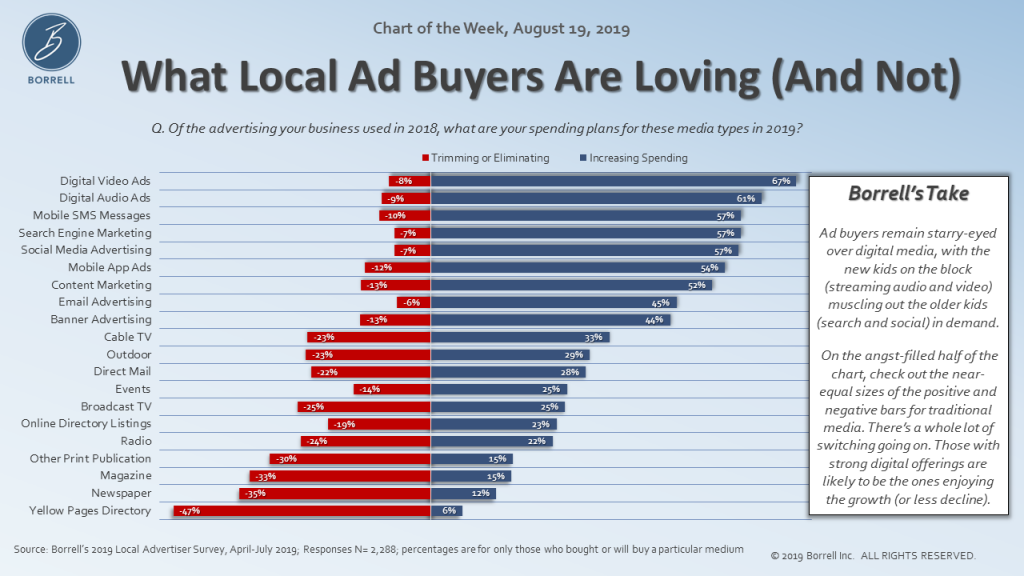
Not surprisingly, the digital tool kit is clustered near the top of this chart. Digital video ads are most in favor – to the chagrin of radio sales managers. While two-thirds of Borrell’s more than 2,000 local advertisers say they’ll increase spending in this hot sector, only 8% are in the trimming mode.
Where it gets interesting is when you look at traditional media other than print. Look at broadcast TV, direct mail, outdoor, and yes, radio. Talk about a schizophrenic advertising mindset. It seems that for every local media figure eager to advertise on radio, another is running away from AM/FM.
So, how would John Wanamaker explain this dichotomy? How can the efficacy of advertising platforms that have been around for decades and decades be a debatable issue in 2019?
Borrell’s thought is an interesting one:
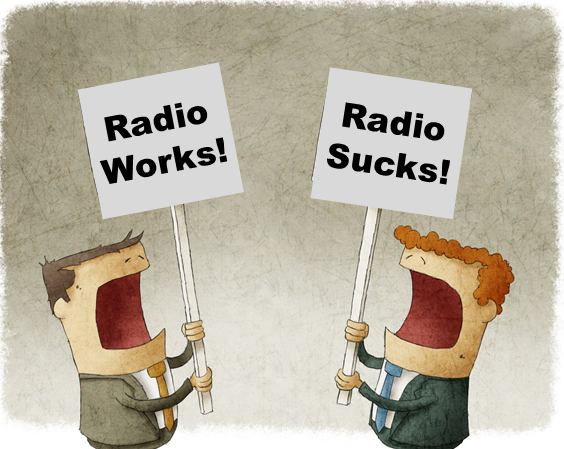 “Hands-down it’s the sales rep. High compliments go to the ones who are helping the advertisers with other forms of marketing and creative ideas.”
“Hands-down it’s the sales rep. High compliments go to the ones who are helping the advertisers with other forms of marketing and creative ideas.”
As for reps who don’t have a clue, they can be the make/break that determine whether the station (and the company that owns it) ends up with the business.
In his survey, Borrell included this open-ended question:
“What has the greatest influence on your advertising buys?”
Interestingly, more than one-third of the respondents – 800+ – commented. Gordon shared some representative comments. And as you’ll read, reps often are the difference-makers. Some even mention them by name:
“If I can know, like, and trust my salesperson, I will always buy from them. When they are pushy I wouldn’t buy from them regardless of how badly I want what they have to offer.”
“I definitely favor certain ad reps and probably buy more based on the person I am working with, but my primary concern is reaching the specific customer we are targeting.”
“A rep can make all the difference, those who get involved and learn a prospective business have everything to gain.”
“(The) sales rep certainly is part of the influence, and cost, of course.”
“I would say the sales rep/expert does influence. Also, having had a previous negative experience with the rep influences future purchases from the company. The rep was not knowledgeable about the product/service she sold. She seemed offended or surprised that I asked so many questions. I ended up paying someone else to help me understand the product/service. Then found out the company did not provide social media advertising as targeted as we wanted.”
“Sales reps come and go too fast. They are the first line in presenting it though, and do influence us. The company’s rep is big also, but the type of media is what will drive the ultimate sale. Value versus cost.”
And Borrell has the stats that strongly suggest that when a sales rep drops the ball or doesn’t represent their company well, the advertisers doesn’t drop radio. Instead, they’re more likely to give their business to another station/cluster in town.
Radio selling used to be a one-size-fits-all proposition. Buying 30s and 60s was the “secret sauce” for every advertiser – the only question was how many spots over how many weeks and their rate.
Today, savvy sellers are able to truly assess a client’s need, and architect an integrated plan that includes both traditional advertising as well as a menu of other assets – websites, apps, event marketing, podcasts, and more.
Problem is, their supply is quite a bit smaller than the outsized demand for sales reps who “get it.”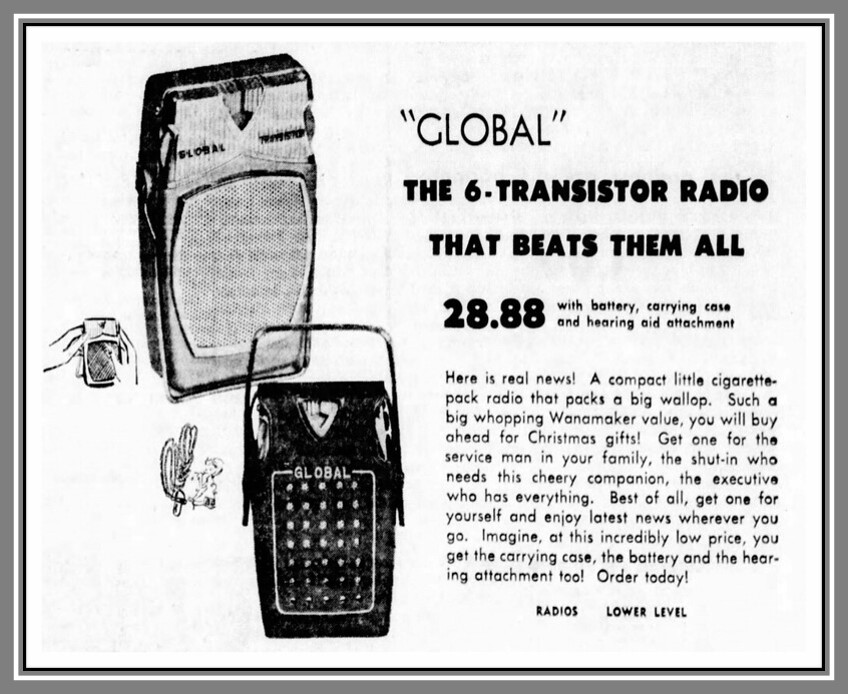
And as Borrell’s research indicates, advertisers are increasingly mixed about traditional media and its necessity in their marketing programs.
You have to wonder what John Wanamaker would make of the current conundrum.
Rumor is, he was a fan of radio.
Thanks to Keener 13 fanatic & steward, Scott Westerman, for the WKMH rate card.
- What To Do If Your Radio Station Goes Through A Midlife Crisis - April 25, 2025
- A 2020 Lesson?It Could All Be Gone In A Flash - April 24, 2025
- How AI Can Give Radio Personalities More…PERSONALITY - April 23, 2025





Leave a Reply